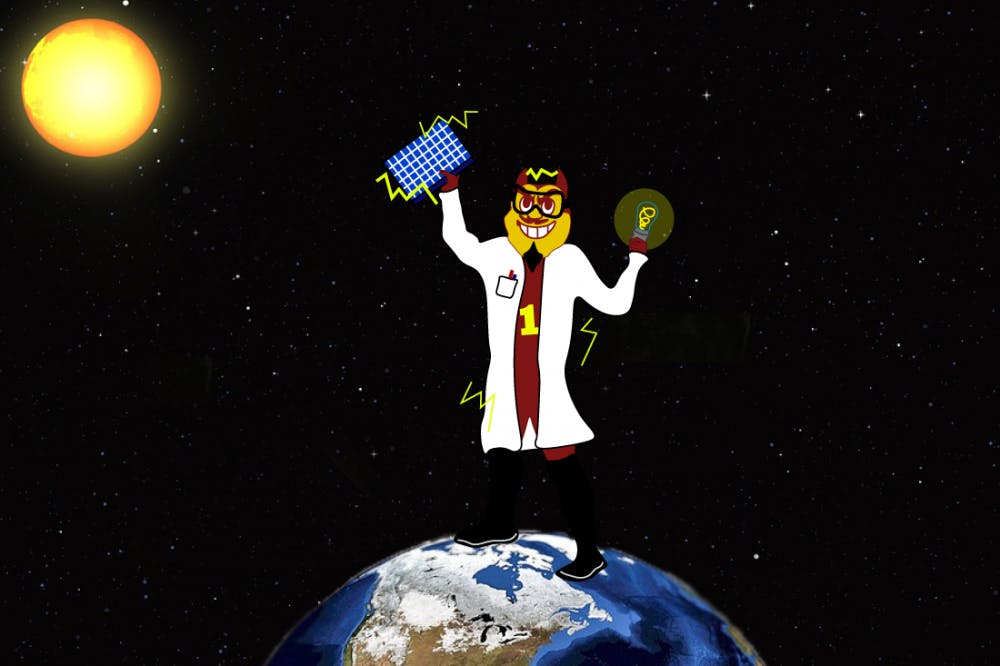Although solar cell technology has been around since the 1950s, it has not advanced to the point where it can replace fossil fuels as society's main source of power.
ASU received six SunShot awards from the U.S. Department of Energy to fund the development of commercial photovoltaic technologies.
The SunShot Initiative was introduced by former President Barack Obama’s administration to promote and reduce the cost of solar energy.
One of the 28 ASU projects funded by the $20.5 million in grants is a project lead by Owen Hildreth, a professor at the School for Engineering of Matter, Transport and Energy (SEMTE), which is aimed at reducing the amount of silver used in the production of solar cells.
“This would reduce the cost of manufacturing and in turn reduce the cost to the consumer. Silver amounts to 30 percent of the manufacturing cost of solar cells,” Hildreth said.
One reason solar cell technology isn’t more widely used by consumers is the high cost of installing solar panels. Hildreth said reducing the cost of manufacturing could result in wider adoption of the technology.
Screen printing is currently the standard in the solar power industry for placing silver in solar cells. This process requires silver flakes to be made into a paste.
“The fundamental drawback of this process is that there is a limit to how thin the layer of silver can be made due to the physics of screen printing a paste,” Hildreth said.
Hildreth and his team are developing a technology formally invented by Jennifer Lewis, a professor at the Harvard John A. Paulson School of Engineering and Applied Sciences, which allows them to print a chemical reaction creating the silver directly on the surface of solar cells.
This bypasses the physical limitations of screen printing silver and doesn’t require the silver to be processed at high temperatures. It also produces silver with higher conductivity.
Avinash Mamidanna, a graduate research assistant for the project and Ph.D student at ASU, was in charge of preliminary testing.
“We’ve gotten promising preliminary results that show that this technology can replace the current technology in the near future," Mamidanna said. "It’s not limited to silver either. We can print multiple materials using this process."
Hildreth and his team are currently in the process of testing whether their technology can keep up with the industry's production standards.
Mariana Bertoni is Hildreth’s co-principal investigator for the project and is also working on three other projects that received funding from the SunShot initiative.
Bertoni is currently collaborating with two of the solar energy industry’s leading manufacturers of thin film solar cells.
Her and her team are in the process of testing thin film based solar cells under real operating conditions to give the manufacturers a better understanding of the films' composition.
Bertoni said the advantage of thin film is its flexibility.
“It can be placed along walls or roofs that don’t have space for large panels,” Bertoni said.
She is also leading a project to reduce the amount of silicon wasted in the process of producing the wafers that house solar cells.
Bertoni’s team has developed a way to wrap silicon blocks in a material similar to aluminum foil. By lowering the temperature surrounding the blocks, they are able to shrink the material and exfoliate the silicon in the shape and size needed.
These projects make ASU a significant contributor to the SunShot Initiative’s goal of bringing the price of solar power down to that of conventional power by 2020.
Reach the reporter at cazares429@gmail.com or follow @sonic_429 on Twitter.
Like State Press on Facebook and follow @statepress on Twitter.




